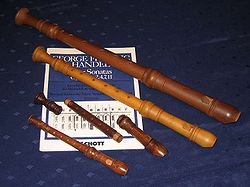Recorder (instrument)

Various recorders (second from the bottom disassembled into its three parts)
|
|
| Woodwind instrument | |
|---|---|
| Other names |
German: Blockflöte |
| Classification | |
| Hornbostel–Sachs classification | 421.221.12 (Flute with internal duct and finger holes) |
| Playing range | |
| Soprano recorder: C5–D7(G7) | |
| Related instruments | |
| Musicians | |
| Recorder players | |
German: Blockflöte
Italian: Flauto dolce or Flauto diritto
French: Flûte à bec or Flûte douce
Spanish: Flauta dulce or Flauta de pico
Japanese: リコーダー (rikōda) or 縦笛 (tatebue)
Portuguese: Flauta doceBR or flauta de biselPT
Swedish: Blockflöjt
Danish: Blokfløjte
The recorder is a woodwind musical instrument in the group known as internal duct flutes—flutes with a whistle mouthpiece. It is distinguished from other duct flutes by having thumb-hole for the upper hand and seven finger-holes: three for the upper hand and four for the lower. It is the most prominent duct flute in the western classical tradition.
Recorders are made in different sizes with compasses corresponding to different vocal ranges. The sizes most commonly in use today are the soprano (lowest note C5), alto (lowest note F4), tenor (lowest note C4) and bass (lowest note F3). Recorders are traditionally constructed from wood and ivory, although the use of plastics is now common. Other characteristics of their construction, such as bore profile and fingering systems, have varied over time and between instruments.
The recorder is first documented in the Middle Ages, and continued to enjoy wide popularity in the renaissance and baroque periods, but was little used in the classical and romantic periods. It was revived in the 20th century as part of the historically informed performance movement, and became a popular amateur and educational instrument. Composers who have written for the recorder include Monteverdi, Lully, Purcell, Handel, Vivaldi, Telemann, J. S. Bach, Paul Hindemith, Benjamin Britten, Leonard Bernstein, Luciano Berio, and Arvo Pärt. Today, there are many professional recorder players who demonstrate the instrument's full solo range and a large community of amateurs.
...
Wikipedia

